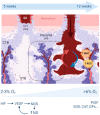The Impact of Oxidative Stress of Environmental Origin on the Onset of Placental Diseases
- PMID: 35052610
- PMCID: PMC8773163
- DOI: 10.3390/antiox11010106
The Impact of Oxidative Stress of Environmental Origin on the Onset of Placental Diseases
Abstract
Oxidative stress (OS) plays a pivotal role in placental development; however, abnormal loads in oxidative stress molecules may overwhelm the placental defense mechanisms and cause pathological situations. The environment in which the mother evolves triggers an exposure of the placental tissue to chemical, physical, and biological agents of OS, with potential pathological consequences. Here we shortly review the physiological and developmental functions of OS in the placenta, and present a series of environmental pollutants inducing placental oxidative stress, for which some insights regarding the underlying mechanisms have been proposed, leading to a recapitulation of the noxious effects of OS of environmental origin upon the human placenta.
Keywords: DNA methylation; P38MAPK; environmental pollution; heavy metals; hypertensive disorders of pregnancy; placenta; placental diseases.
Conflict of interest statement
The authors declare no conflict of interest.
Figures



References
Publication types
LinkOut - more resources
Full Text Sources

